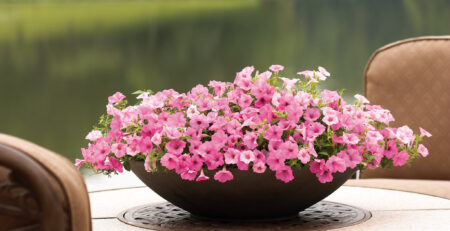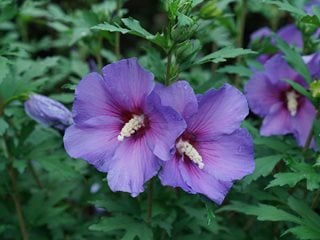Slide
0CART $0.00
Back to Blog
Back to Blog


“That which we call a rose, by any other name would smell as sweet…” – William Shakespeare.
Despite its name, Rose of Sharon is not related to garden roses in any way. Hibiscus Syriacus, or Rose of Sharon, is more closely related to the mallow family (Malvaceae), which includes okra, cotton, hollyhock, and marsh mallow. The name “Rose of Sharon” made its first appearance in the Hebrew Tanakh, translated into English in the 1600s. “I am the rose of Sharon, a rose of the valley.” However, the translation from Hebrew most likely applied to another flowering plant entirely and not to the plant that we call Rose of Sharon today.
Origins and History:
Rose of Sharon is native to South China, Taiwan, and India. It has been grown for centuries for its ornamental beauty and medicinal properties. The Chinese used its dried root bark as an anti-fungal remedy and diuretic. Trade brought it to Japan, where it was first recorded as an ornamental plant in the 8th century. Rose of Sharon was later imported to Korea from Japan in the 15th century, and it became so well-loved that it was named “The Eternal Blossom That Never Fades” and even mentioned in the South Korean national anthem. The plant was introduced by seed to Europe in the 16th century by Dutch traders and was later brought to the Middle East, where it thrives in the heat and sun. By the 18th century, the shrub was common in English gardens, and it was also brought to the Americas by colonists who appreciated its beauty. Even Thomas Jefferson grew Rose of Sharon from seed and planted them at all three of his homes. During the Victorian era, the Rose of Sharon was particularly popular, as it was seen as a symbol of femininity.
Modern Cultivars and Features:
Today, there are plenty of popular modern cultivars of Rose Of Sharon (Hibiscus Syriacus) grown in gardens all over the world. This deciduous shrub boasts abundant mid- to late-summer flowers, making it a favorite among gardeners. One of the key factors contributing to its popularity is its extended bloom season combined with its low maintenance requirements, making it an excellent choice for both seasoned and new gardeners.
The blossoms of Rose of Sharon have five-petal flowers in single and double forms, which stay open for one day. The double varieties have an assortment of additional petaloids circling the flower’s center, providing the look of a pretty sea anemone. Overall, the blooms have a faint sweet fragrance and are available in shades of pink, lavender, violet, blue, and white, with flowers ranging from 2 to 4 inches wide, depending on the variety. Most Rose of Sharon flowers also have a darker eye zone in maroon to red, with some even having “fingers” radiating out from the center of the flower.
Rose of Sharon is partially deer resistant but may not be the best choice if you have a large deer population in your area.
Care:
Ideal growing conditions for Rose of Sharon include full sun and well-drained soil; however, they are tolerant of most soil conditions, with the exception of continually wet or marshy soils or sand. If you notice unopened bud drop or yellow foliage on your plant, it usually indicates overwatering. In case you have automatic irrigation and see yellow foliage, dial back the timer setting by half or redirect the emitter. Once established, Rose of Sharon can tolerate dry conditions, but during severe droughts, supplemental watering is recommended. For the first year after planting, be sure to water regularly until the plant becomes dormant in autumn. Rose of Sharon benefits from an annual top dressing of compost in the spring, while autumn fertilizing is not recommended. Although this shrub will tolerate partial shade, planting in full sun will offer the best performance. Shaded plants may be susceptible to bacterial leaf spotting and produce fewer flowers. If you observe any foliage exhibiting leaf spotting, remove and destroy it, then spray the remaining foliage with a fungicide.
As this shrub has a loose and open plant habit, lightly pruning it back in late winter to early spring before it leafs out will help maintain a pleasing shape and strengthen the branching. The weight of flowers may bring the branches down, especially after heavy rain, so you may also give it a light trim immediately after it has finished flowering. As Rose of Sharon blooms on new wood, a hard pruning in spring is discouraged, as it will affect flower production for a season. If you need to prune back hard, do not remove more than 1/3 of the plant each season.
Propagation of Rose of Sharon:
Rose of Sharon is easily propagated through early spring to early summer cuttings. These cuttings can be rooted by treating the ends with a rooting hormone powder and placing them directly into the ground in loosened garden soil, ensuring they remain damp. Taking multiple cuttings increases the likelihood of success. Additionally, Rose of Sharon can be easily grown from seed, although they may not necessarily flower true to the parent plant like cuttings do. Seeds should be collected after the seed pods have dried and stored in a cool, dry place over winter. Plant the seeds in about 1 inch of soft soil in the spring and keep the resulting seedlings well-watered.
Location and Uses:
Rose of Sharon is an excellent choice for gardens in the greater New England area, as it is hardy to zone 5 (-20 degrees F). This vase-shaped upright grower usually has multiple trunks and may be available as a standard, which means its central leader has been pruned into a single trunk, while the top foliage was pruned to resemble a small tree canopy. This standard form of Rose of Sharon benefits from spring pruning to maintain the canopy form. The largest varieties may grow to 8-12 feet tall and
6-10 feet wide. However, there are also dwarf varieties, like the ‘Lil Kim’ series, which grow closer to a height of 4-5 feet. The Lil Kim varieties will produce a few seedpods, but if you wish to deadhead their flowers to prevent random self-sowing, they are compact enough to reach.
In the landscape, Rose of Sharon can be planted as a specimen, used as an informal hedge for screening, or planted as a bird garden hedgerow. It may not offer the best hedge coverage in wintertime, as it is deciduous and often slow to leaf out in spring, especially in cooler climates. If used as hedging, plant about 6 feet apart and allow the branches to intertwine. If planted as a specimen, Rose of Sharon becomes the perfect focal point in a pollinator garden as its flowers are attractive to bees, hummingbirds, and butterflies. It may also be integrated into a mixed border or used as a solution for hot, sunny locations in need of quick coverage. The columnar and shorter varieties may be utilized as elements in a foundation planting. Tolerant of air pollution and salt, it is well-suited for urban and oceanside landscapes that offer less than ideal conditions. While older varieties freely self-sow and may create nuisance seedlings, newer varieties like those in the Satin® family, Sugar Tip®, Purple Pillar®, and the Chiffon® family produce sterile flowers.
Uses Beyond Ornamentation:
Beyond its ornamental features, Rose of Sharon serves various other purposes. Flowers and leaves from Rose of Sharon are used by hobbyists to make a dye to color fabrics and yarns a soft green, grey, or tan, depending on the mordant. All parts of the Rose of Sharon are edible, including seeds, foliage, open flowers, and flower buds. Even the fibrous root is edible. The mucilaginous leaves can be used as a thickener for soups and stews. The mild-flavored flowers and young leaves may be eaten raw in salads. Dried Rose of Sharon flowers are used medicinally by herbalists to lower blood pressure and address digestion issues. The plant is not dangerous if eaten by dogs, cats, or horses.
Companion Plants for Rose of Sharon:
Because Rose of Sharon produces its blooms later in the season, it is an ideal addition to a mixed border, providing much-needed color in the landscape. Mix them in with evergreens that provide winter structure, as Rose of Sharon is among the last to leaf out in spring, especially in cooler climates. Evergreen choices may include sun-loving junipers, chamaecyparis, hollies, spruces, and pines. When planting your border, be sure to allow sufficient space for plants to grow. To create a color display lasting all season, plant Rose of Sharon with other deciduous shrubs that require the same growing conditions but flower at different times. Choose lilac (early), viburnums (early to mid-season), roses (mid-season to late depending on variety), arborescens hydrangea (mid-season), and panicle hydrangea (late season). Underplant with sun-loving perennials such as aster, coneflower, phlox, globe thistle, late-season daylilies, shasta daisy, Russian sage, and rudbeckia. Plant the same perennials in groups of 3, 5, or 7 rather than single plants to create a more cohesive look.
Rose of Sharon lends itself to theme gardens, particularly for an old-fashioned cottage garden design. For an old-fashioned cottage garden look, plant thickly and allow plants to grow together en masse. There are no hard and fast rules for cottage gardens, which tend to be personal, somewhat chaotic expressions of color and form. One way to tame the chaos is to work within a color palette featuring flowers and foliage. Blue, lavender, white, and silver work well together, or you might prefer a garden of exciting brights, including reds, yellows, and oranges. Muted colors like pinks, blues, and whites are sweet and calming. Rose of Sharon looks lovely in the cottage garden when planted with alliums, roses, lavender, foxglove, coreopsis, echinacea, and any flowers with a traditional daisy shape.
The large white-flowered Rose of Sharon makes an ideal backdrop for a moon garden. The variety ‘Sugar Tip’ offers interesting white-edged variegated foliage and small pink blooms resembling double hollyhocks. Use them in a silver-themed garden combined with white azaleas, panicle hydrangeas, white shasta daisies, white and cream roses, lamb’s ear, variegated iris, achillea, and veronica. Annuals that work well in moon gardens are climbing moonflowers, petunias, white caladium, dusty miller, and annual artemisias.
Use Rose of Sharon as a visual anchor in a pollinator garden, combining it with earlier blooming flowering shrubs and native pollinator-friendly perennials, as it blooms late in the season. Good perennial choices for a pollinator garden include creeping thyme, agastache, catmints, monarda (bee balm), yarrow, goldenrod, liatris, mint, and sedum. Add in annuals like salvia, lantana, lobelia, and sweet alyssum.
Rose of Sharon offers a range of color choices and forms for many landscape applications:
Pink:
– Aphrodite: Beautiful rose-pink flowers with a small bullseye maroon center. Produces little to no seed.
– Sugar Tip: Sterile. Semi-dwarf. Double pink with a bisected eye zone and a maroon eye. Variegated foliage with an edge of white.
– Minerva: Abundant, lavender-pink flowered variety with a dark red center. Dense foliage. Mostly sterile but still may produce seed.
– Lil Kim Red: A dwarf variety with dark pink flowers and a small red eye zone. Will produce a few seeds.
Lavender-Purple:
– Purple Pillar: Pinky-lavender flower with a maroon eye. Narrow and upright columnar cultivar with a more condensed plant habit. Sterile.
– Lil Kim Violet: Dwarf variety with 3” purple-violet flowers with a dark red eye. Good dark green foliage. Will produce a few seeds.
– Purple Satin: Sterile. Dark purple single flowers with a dark maroon eye.
Blue:
– Azurri Blue Satin: Sterile. Blue-lavender to periwinkle blue blooms with an eye zone of magenta.
– Blue Chiffon: Sterile. A single blue flower with lavender overtones and an unusual lacy center. Hint of a maroon eye zone among the multiple petals.
White:
– Red Heart: An older variety with white petals and a dark red heart. Sterile.
– White Chiffon: Solid white flowers with a tightly clustered double center. Sterile.
– Lil Kim: A dwarf variety with a refined upright habit, reflexed flat, white flowers, and a dark red-maroon eye zone. Will produce a few seeds.
– Diana: Award winner! A pure white older variety with a large, flat flower 4-5 inches across. Sterile.
Related Posts
08May
Planting Guide: Window Boxes
May is here, and our annuals are coming out of our greenhouses every day! It's time to start planning your... read more

18Apr
‘Supertunia Summer’ at Nunan’s Garden Center
This summer, Nunan's Garden Center invites you to participate in our 'Supertunia Summer' event, showcasing the vibrant and diverse Proven... read more
24Jul
The Importance of Pollinators
In this industry, we get a lot of requests for plants that will attract butterflies, bees, and hummingbirds to... read more
17Jun
Guide: Roses
Roses are a beautiful addition to any garden design, but they have a bit of a reputation. Whether they're not... read more
28May
11 Plants to Repel Bugs: An Eco-Friendly Solution
With warmer weather coming, so are the bugs. Insect pests like flies and mosquitoes can make enjoying your summer patio... read more
14Jul
Caring For Cactus And Succulents
Of the endless possibilities of houseplants, cacti and succulents seem to be the easiest and lowest-maintenance. They make an interesting... read more
10Apr
2018 Proven Winner Annual Varieties
This year, Nunan's will be featuring a number of new Proven Winner-brand annuals, grown right here in our numerous growing... read more

08Mar
It’s Going To Be A ‘Supertunia Summer’ At Nunan’s!
We are celebrating one of our favorite plants from the Proven Winners family! The Supertunia® series by Proven Winners represents... read more
27Jun
Drought-Tolerant Perennials
With the New England summer underway, you can expect the weather to get hot and dry. While this can be... read more
24Jul
Guide: Midsummer Care Guide for Annuals
The heat is on! Summer can be a wonderful time for plants, and it can also be brutal. Heatwaves can... read more
© Copyright 2023. All Rights Reserved.






